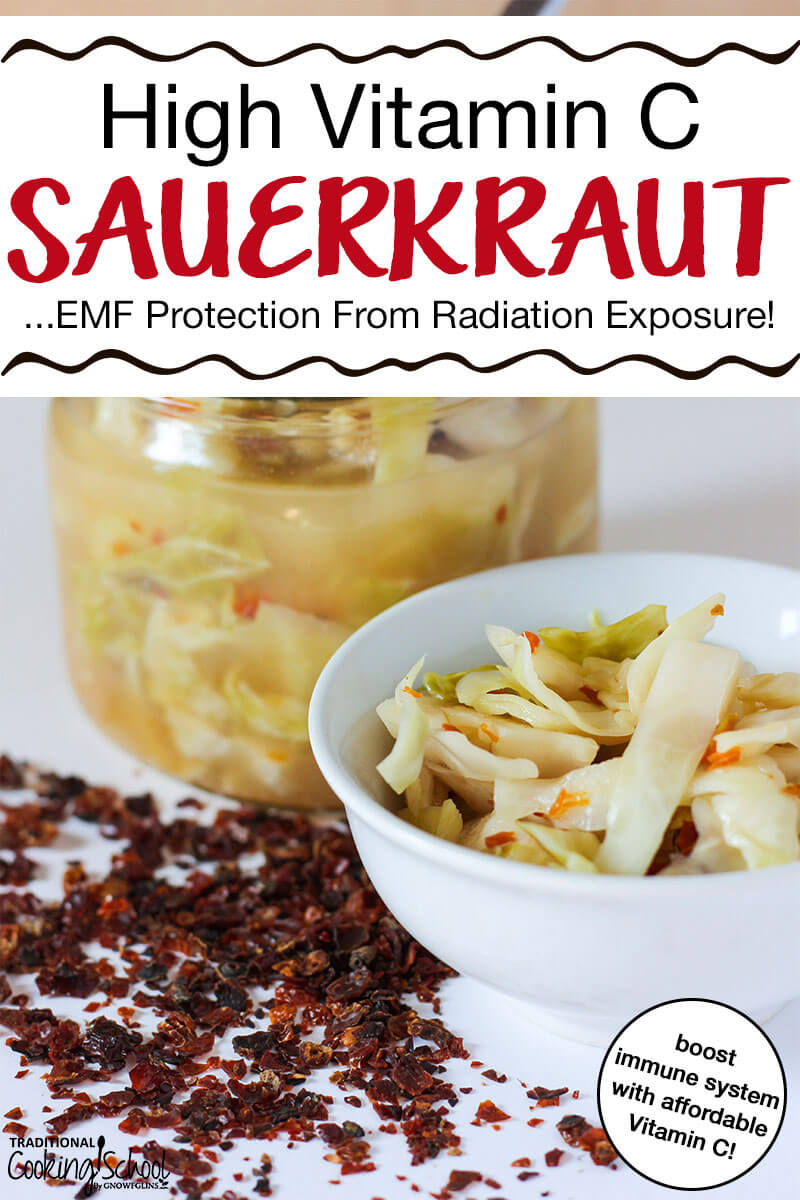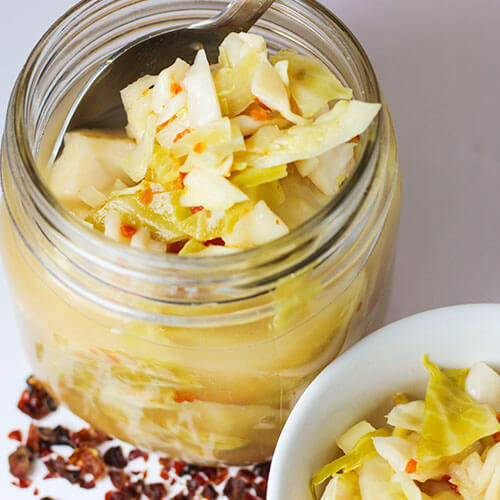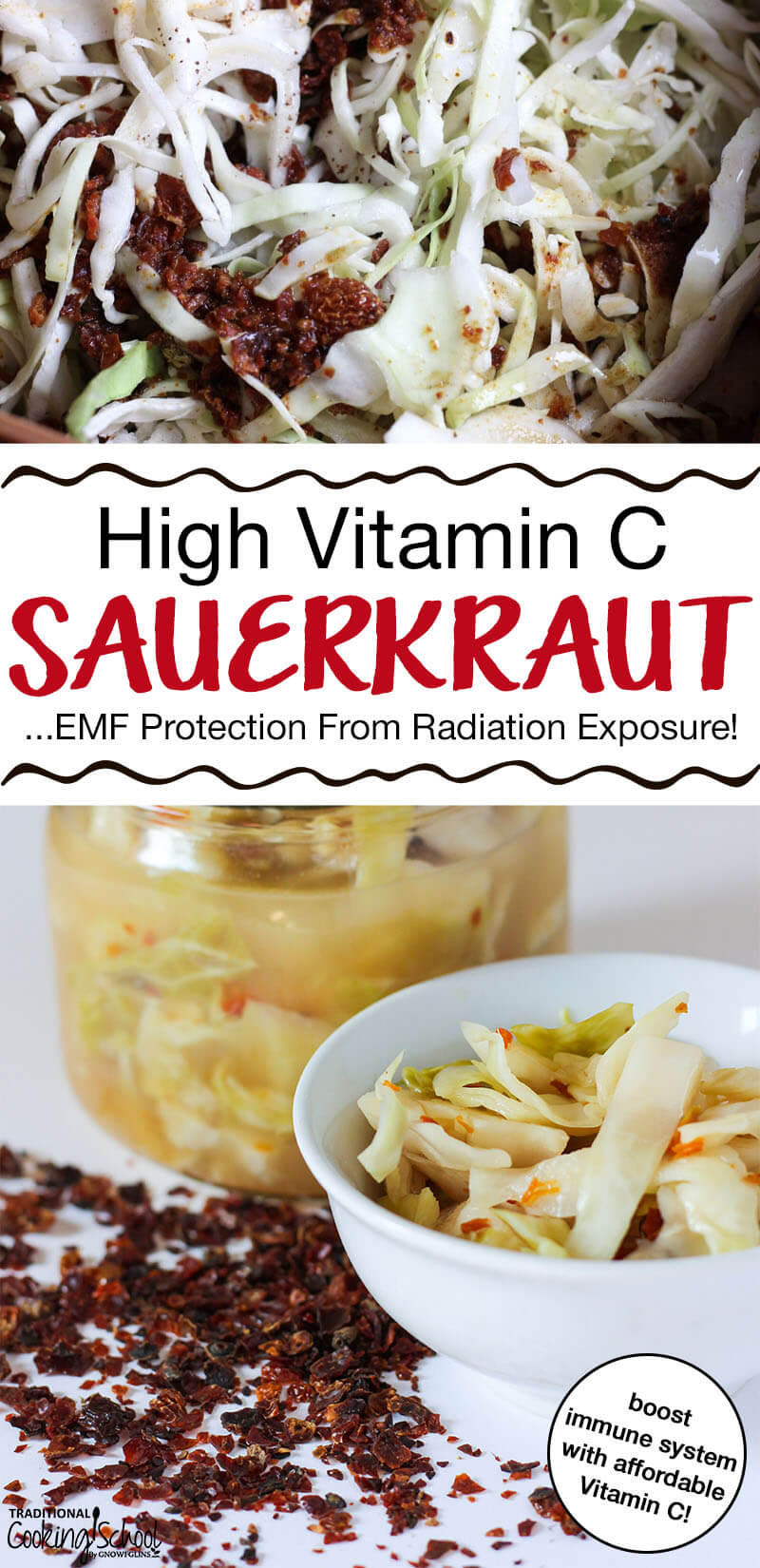
How much electromagnetic radiation are you exposed to each day?
In our daily lives, most of us are exposed to low doses of radiation on a regular basis. Radiation sources include cell phones, x-rays, and airport screenings.
Low-dose radiation exposure can be more subtle than x-rays and cell phones, though. Daily we’re confronted with computers, smoke detectors, WIFI routers and cigarette smoke (source).
If we know we’re going to be exposed to more radiation on a given day (for example, traveling and going through security at the airport, or having a necessary x-ray), what can we do?
Vitamin C & EMF Protection (Anti-Radiation Benefits)
Amazingly, Vitamin C blocks the effects of radiation (source)!
Many fields now look to Vitamin C to combat the effects of radiation and prevent cancer. Vitamin C supplementation is valued as a preventative measure prior to nuclear radiation exposure. And Vitamin C is used by many practitioners during and after cancer treatment (source and source).
Experts who recommend Vitamin C as a form of prevention and treatment suggest 3 to 4 daily doses.
That’s why I chose to make this High Vitamin C Sauerkraut with Rose Hips! I enjoy it daily with my meals (it’s delicious!) as a food-sourced, natural layer of defense for my body in a world bombarded with toxins.
While supplemental Vitamin C taken 3 to 4 times daily is unrealistic and costly… eating high Vitamin C sauerkraut is easy and inexpensive.
Fermented products have long been utilized for their EMF protection and anti-radiation benefits. This High Vitamin C sauerkraut with rose hips pairs probiotic (and Vitamin C rich) sauerkraut with an herb renowned for being a high Vitamin C food, creating a SUPERfood of bioavailable nutrients! The Vitamin C in rose hips becomes even more pronounced through fermentation.
The flavor is tangy and delicious! Try pairing sauerkraut with spare ribs like Grandma Mabel’s.

High Vitamin C Sauerkraut With Rose Hips
No pound fermented sauerkraut just got even more special... Say hello to High Vitamin C Sauerkraut! It's tangy and delicious, but that's not all. This homemade sauerkraut also boosts the immune system and provides EMF protection! Do you need a DIY, budget-friendly way to shield yourself from daily radiation exposure? Get ready to detox with only 4 ingredients: cabbage, rose hips, water, and sea salt!
Ingredients
- 1 cabbage medium
- 2 cups pure water
- 1/4 cup rose hips pulverized in coffee grinder so largest pieces are about the size of a peppercorn
- 2 tablespoons sea salt
Instructions
-
Finely shred cabbage, discarding core.
-
Place cabbage in large bowl with filtered water and sea salt. Stir slightly.
-
Cover and set aside for 30 minutes.
-
Toss cabbage again.
-
Re-cover and set aside for an additional 30 minutes.
-
Pack into fermenting crock of choice, layering it as you go with dried rose hips.
-
Pour any remaining salted water in the large bowl over the cabbage and rose hips.
-
Press down firmly to pack tightly and remove air bubbles.
-
Seal according to crock instructions, or use pickling weights and fermentation lids. (See fermentation tool options below.)
-
Let ferment in warm, dark location.
-
After 12 to 24 hours, pack cabbage down again to make sure that it is beneath the brine.
-
Allow to ferment for 7 days or longer. Transfer to cold storage where flavors will continue to develop.
Recipe Notes
- This High Vitamin C sauerkraut with rose hips pairs probiotic (and Vitamin C rich) sauerkraut with an herb renowned for being a high Vitamin C food, creating a SUPERfood of bioavailable nutrients!
- The Vitamin C in rose hips becomes even more pronounced through fermentation.
Looking for another variation? Sometimes I add broccoli to my sauerkraut. Broccoli is also high in Vitamin C, and its nutrition becomes more bioavailable through fermentation. Broccoli and cabbage pair well together.
My Favorite Fermentation Tools
- I use this modern Korean crock, designed to make large, regular amounts of kimchi.
- These weights, fitted for Mason jars, help your ferment stay under the brine without any hassle!
- These airlock lids allow your ferment to breathe, while it remains anaerobic. No burping is necessary to release the built up CO2 with these lids.
- Finally, Wardee recommends and loves all Ohio Stoneware products, including the crock, lid, and weights!
Don’t Forget The Extra Brine!
The above recipe uses a no-pound method that incorporates water and sea salt, much like pouring a salt brine over pickles. This method also provides extra brine, which I use for 2 purposes…
My family likes to drink the brine for a quicker source of probiotics. For instance, when we’re eating in the midst of a busy day, and don’t want to pull out sauerkraut from the jar with a fork.
I also use sauerkraut juice regularly to inoculate other fermented foods or soaked batters. Here are some recipes you may enjoy that use sauerkraut juice: Beet Kvass, Paleo Sourdough Waffles, and Paleo Sourdough Bread.
More Ways To Combat Environmental Toxins & Heal Your Body
- How and Why to Drink Bentonite Clay (for anti-radiation, detoxification, gut-healing and more)
- How (and Why) to Take VITAMIN C with COLLAGEN… to HEAL THE GUT!
- Rocket Fuel In Breast Milk & Drinking Water??? 7 Ways To Detox Naturally
- DefenderShield— offering amazing products that block EMF radiation emitted from your laptop, tablet, phone, and more… keeping you and your family safer!
Will you try this high Vitamin C sauerkraut with rose hips?
Other Fermented Vegetable Recipes
- Homemade Sauerkraut In A Stoneware Crock
- Simple, No-Pound Sauerkraut
- Homemade Kimchi: An Easy Korean Sauerkraut Recipe
- Old-Fashioned, Crunchy, Fermented Garlic-Dill Pickles
- Lacto-Fermented Carrot Sticks
- 5-Spice Apple Chutney {lacto-fermented!}
- Spontaneously Fermented Sparkling Apple Cider {fall’s easiest ferment!}
- Homemade Raw Apple Cider Vinegar Recipe
- Lacto-Fermentation archiveshere at Traditional Cooking School
We only recommend products and services we wholeheartedly endorse. This post may contain special links through which we earn a small commission if you make a purchase (though your price is the same).



Do you dry your own rose hips or do you buy them?
Hi Allison, I’ve done both. This year I purchased them, but in years past we have foraged for them.
Can’t wait to make this tomorrow! This may be a silly question but when you transfer to cold storage do you remove the fermenting lids and use a regular lid? I have the silicone ones, love them!
Hi Dawn, yay!! I’m so glad you’ll be making this! It’s one of my favorites. No such thing as silly questions, right? 🙂 Yes, remove the fermenting lids and replace with regular lids. Cheers!
Ok thank you! I thought that was probably the procedure but it’s been a while since I’ve fermented anything.
I was really surprised how much cabbage I could pack into one quart mason jar, too. I’m not sure if my cabbage was “medium” or not, I picked the largest organic one at a local co-op but it wasn’t what I would consider large. I got all but one small handful in one jar. Really looking forward to eating this!
Hi there,
I seem to have inconsistent results. My first batch was SOOOOOOO good, the best kraut ever. The second batch I used tea bag cut Rose hips and I had the white yeast form on top (which I scraped off), but the batch had almost no liquid above the kraut after fermenting and while I don’t think its gone bad, it doesn’t taste SOOOO good, it’s kind of like a question mark taste if that makes any sense!